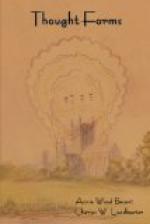Another consideration which must not be forgotten is the type of matter in which these forms are generated. If a thought be purely intellectual and impersonal—for example, if the thinker is attempting to solve a problem in algebra or geometry—the thought-form and the wave of vibration will be confined entirely to the mental plane. If, however, the thought be of a spiritual nature, if it be tinged with love and aspiration or deep unselfish feeling, it will rise upwards from the mental plane and will borrow much of the splendour and glory of the buddhic level. In such a case its influence is exceedingly powerful, and every such thought is a mighty force for good which cannot but produce a decided effect upon all mental bodies within reach, if they contain any quality at all capable of response.
If, on the other hand, the thought has in it something of self or of personal desire, at once its vibration turns downwards, and it draws round itself a body of astral matter in addition to its clothing of mental matter. Such a thought-form is capable of acting upon the astral bodies of other men as well as their minds, so that it can not only raise thought within them, but can also stir up their feelings.
THREE CLASSES OF THOUGHT-FORMS
From the point of view of the forms which they produce we may group thought into three classes:—
1. That which takes the image of the thinker. When a man thinks of himself as in some distant place, or wishes earnestly to be in that place, he makes a thought-form in his own image which appears there. Such a form has not infrequently been seen by others, and has sometimes been taken for the astral body or apparition of the man himself. In such a case, either the seer must have enough of clairvoyance for the time to be able to observe that astral shape, or the thought-form must have sufficient strength to materialise itself—that is, to draw round itself temporarily a certain amount of physical matter. The thought which generates such a form as this must necessarily be a strong one, and it therefore employs a larger proportion of the matter of the mental body, so that though the form is small and compressed when it leaves the thinker, it draws round it a considerable amount of astral matter, and usually expands to life-size before it appears at its destination.




